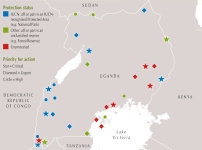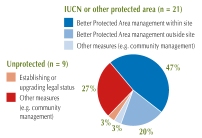
Some 55% of the 159 Important Bird Areas in Ethiopia, Kenya and Uganda have been assessed as being ‘highly threatened’, including many which are formally protected. For eight of the nine unprotected IBAs in Uganda, community-based management, rather than formal designation, is thought to be the more appropriate means of ensuring their protection.

Three BirdLife Partner Organisations in East Africa (NatureKenya, NatureUganda and the Ethiopian Wildlife and Natural History Society) have carried out an exercise to set priorities for action among their Important Bird Areas (IBAs). Biological value (based on bird importance scores) and overall threat were each summarised on a four-point scale and combined to give urgency scores (a measure of the likely biodiversity loss if no action is taken soon).
Of the 159 IBAs in the three countries, more than half (55%) were assessed as highly threatened (scores of 3 or 4). Even among IUCN-recognised protected areas (categories I–VI), 45% of sites were highly threatened. Other kinds of protected areas, such as Forest Reserves, were substantially more threatened than sites with no protection (see figure a).

For Uganda, the 30 IBAs were assigned to three classes for conservation action based on their urgency scores: ‘critical’ (the most pressing), ‘urgent’ and ‘high’ (figure b). The 11 critical sites include four National Parks (the highest level of legal protection), showing once again that legal designation is no guarantee of effective protection. In three of these National Parks, however, the most pressing management issues lie outside the site. For the unprotected IBAs, community-based management—rather than designation under current protected areas legislation—appears to be more appropriate for nearly all (figure c).

Compiled: 2004 Copyright: 2004
Recommended Citation:
BirdLife International (2004)
Protected-area designation may not be the full, or best, solution for conserving African IBAs.
Downloaded from https://datazone.birdlife.org/sowb/casestudy/protected-area-designation-may-not-be-the-full-or-best-solution-for-conserving-african-ibas on 22/12/2024